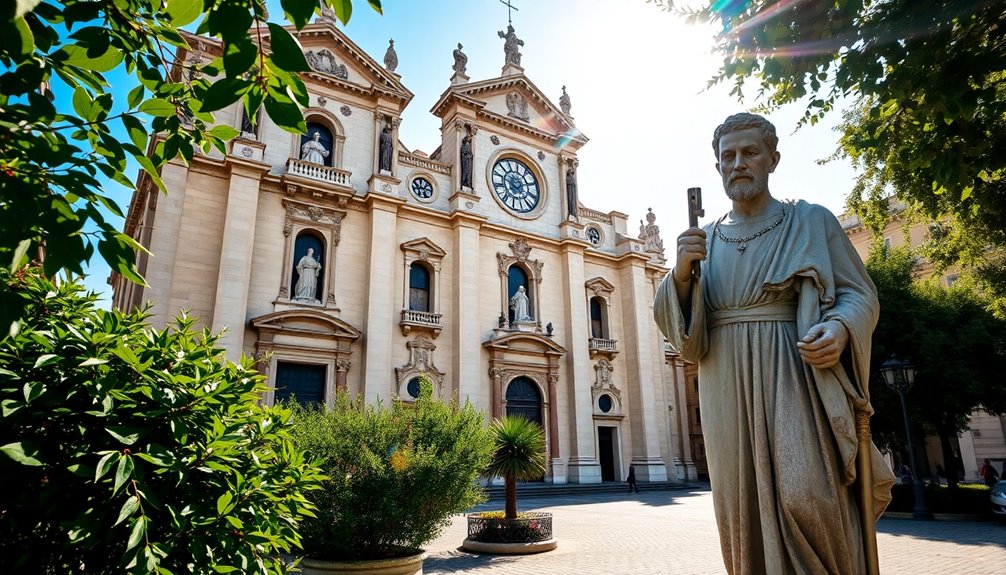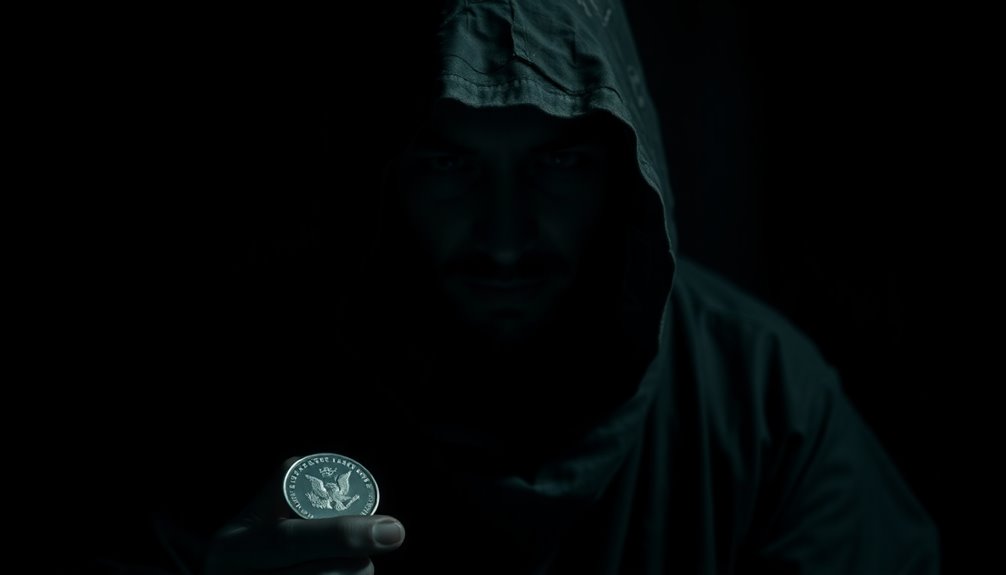You can trace the founding of the Catholic Church back to Jesus Christ, who laid its foundations through His teachings and the apostles. When Jesus appointed Saint Peter as the first leader, He established an influential spiritual lineage. This pivotal moment happened around 30 CE, amidst social and political changes. The Church's mission officially began at Pentecost, marking a commitment to spreading the Gospel. From Peter's leadership to the Apostolic succession that followed, the Church has maintained its integrity and authority. If you want to uncover more about its early developments, there's plenty more to explore.
Key Takeaways
- The Catholic Church was founded by Jesus Christ through his teachings and the actions of his apostles.
- Saint Peter is recognized as the first pope and a central figure in the early Church's establishment.
- Pentecost marks the beginning of the Church's mission when the apostles began preaching the Gospel.
- The term "Catholic Church" first appeared in the writings of Ignatius of Antioch around 110 AD.
- Apostolic succession from Saint Peter to current bishops ensures the continuity of spiritual authority in the Church.
Introduction

The Catholic Church's origins trace back to Jesus Christ, who laid its foundation through his teachings and the selection of his apostles. You can see that Jesus' public ministry was pivotal; it's during this time that he imparted crucial teachings to his followers.
After his resurrection, the outpouring of the Holy Spirit at Pentecost marked the beginning of the Church's mission, empowering the apostles to spread his message.
Saint Peter, one of the most prominent disciples, is recognized as the first pope and played a central role in the early Church's development.
Catholic Church teaches that apostolic succession, the uninterrupted transmission of spiritual authority from the apostles to present-day bishops, is essential for maintaining the Church's integrity. This succession began with Peter, ensuring that teachings of Jesus would be preserved and passed down through generations.
Biblical Basis for Founding

When you look at the biblical basis for founding the Catholic Church, key scripture references stand out.
Jesus' designation of Peter as the rock in Matthew highlights the foundation of Church leadership.
Additionally, the events of Pentecost illustrate the empowered launch of the Church's mission.
Primary Bible References
Rooted in Scripture, the founding of the Catholic Church is clearly illustrated through key biblical references. In the Gospel of Matthew 16:18, Jesus designates Peter as the "rock" upon which he'll build his Church. This moment establishes the foundation for papal authority and apostolic succession, highlighting Peter's role in the Church's leadership.
Furthermore, in Matthew 28:19-20, Jesus commissions the apostles to make disciples of all nations, underscoring the Church's mission to spread the Gospel.
The events of Pentecost, described in Acts 2:1-4, mark a pivotal moment in the Church's history. Here, the apostles receive the Holy Spirit, empowering them to preach and perform sacramental actions, thus initiating the Church's public ministry. This divine guidance is crucial for understanding the Church's identity and purpose.
Additionally, the term "Catholic," first used by Saint Ignatius of Antioch around 110 AD, reaffirms the early Church's unifying vision as a body of believers.
Together, these biblical references form a solid foundation for the Catholic Church, illustrating its roots in Jesus' teachings and the apostolic tradition.
Secondary Bible References
How do secondary biblical references further illuminate the foundation of the Catholic Church? They provide a deeper understanding of how Jesus Christ established his Church through his teachings and the commissioning of his apostles.
In Matthew 16:18, Jesus names Peter the "rock" upon which he'll build his Church, emphasizing the importance of apostolic succession in Catholic theology. This pivotal moment illustrates Peter's unique role in the governance of the Church.
Additionally, the Great Commission in Matthew 28:19-20 instructs the apostles to spread the faith, highlighting the Church's mission to make disciples of all nations.
The outpouring of the Holy Spirit on Pentecost, as detailed in Acts 2, marks the beginning of the Church's public ministry, empowering the apostles to lead and nurture Christian communities.
The development of the early Church is captured in the Acts of the Apostles, which outlines how the apostles established governance and structure among the faithful.
These secondary references not only affirm the foundational role of Jesus and the apostles but also illustrate how the Church evolved under the guidance of the Holy Spirit, ensuring its mission continues to this day.
Roman Empire's Religious Landscape
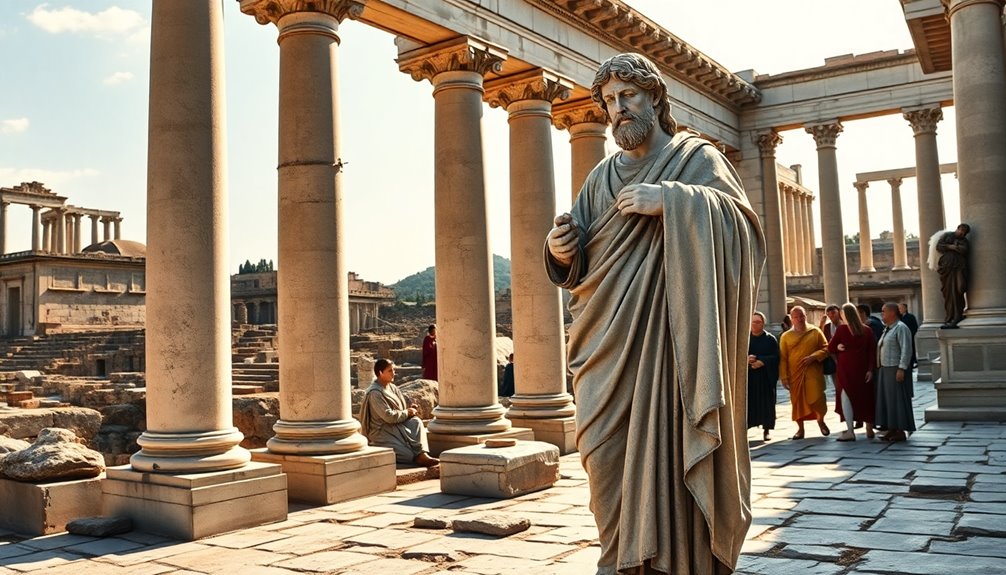
Exploring the religious landscape of the Roman Empire reveals a complex tapestry of beliefs where polytheism reigned supreme. The Empire facilitated a diverse array of faiths, with a pantheon of gods worshipped through public rituals and sacrifices.
Amidst this predominantly polytheistic backdrop, Judaism stood out as a significant monotheistic religion, and Christianity emerged as a sect within Judaism in the 1st century CE. Despite initial opposition, the rise of Christianity gained momentum, leading to the Christians' refusal to join pagan celebrations and worship the emperor.
This refusal sparked sporadic yet organized persecutions, particularly during the late 3rd century. However, everything changed with the Edict of Milan in 313 CE, when Christianity was legalized, granting it legal status and ending official persecutions.
Historical Context of Foundations
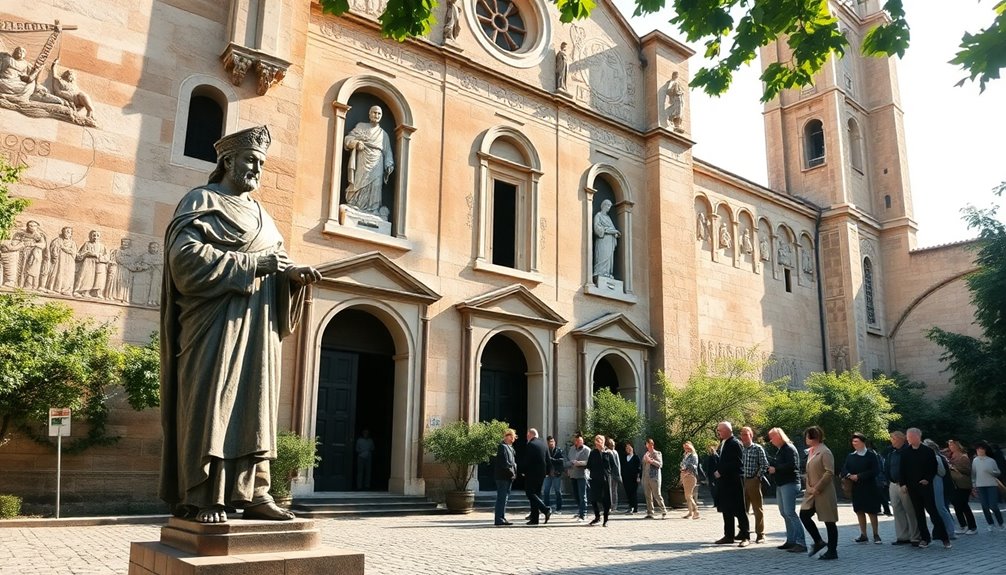
The foundations of the Catholic Church were laid in a turbulent historical context marked by political, social, and religious upheaval. Founded by Jesus Christ around 30 CE, the Church emerged after his death, resurrection, and ascension into heaven. The public ministry began on Pentecost, 50 days post-resurrection, when the apostles received the Holy Spirit, empowering them to spread Christ's teachings.
St. Peter, one of those apostles, became the first pope, establishing the line of apostolic succession that would define Church leadership. His role was crucial in navigating the early challenges faced by believers, particularly during the Council of Jerusalem around 50 AD. This pivotal gathering addressed the inclusion of Gentiles in the Church, allowing them to join without full adherence to Mosaic Law.
The term "Catholic Church" first appeared in the writings of Ignatius of Antioch around 110 AD, distinguishing this growing community from other Christian groups.
This historical context shaped the Church's identity and mission, creating a foundation that would endure through centuries of change and challenge, ultimately leading to the vibrant institution we recognize today.
Misunderstanding Apostolic Succession
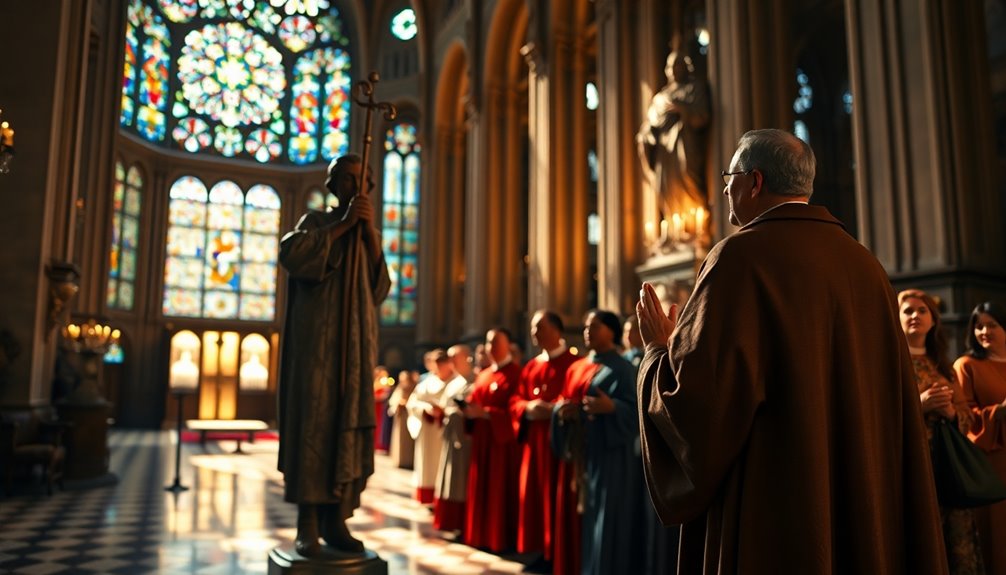
When you think about apostolic succession, it's easy to get caught up in misconceptions.
Understanding the authority of early Church leaders sheds light on how this belief shaped the Catholic Church's structure and teachings.
Let's clear up these misunderstandings and explore why apostolic succession matters.
Debunk Apostolic Succession Misconceptions
Amid ongoing debates about church authority, many misconceptions surround apostolic succession. You might think this concept guarantees a direct line of authority from Peter to the local bishop of Rome, but it's more complex. While the Gospel of Matthew indeed depicts Peter as the rock of the Church, interpretations of his authority vary widely among scholars.
Early Christian communities initially operated with plural presbyters or bishops, promoting a localized leadership structure rather than a centralized hierarchy. This means that governance wasn't uniform across the board; it evolved as the Church grew.
The shift to a single bishop model by the mid-2nd century marked a significant change in understanding apostolic succession, yet this transition happened within a diverse ecclesiastical context.
Critiques of apostolic succession often highlight the lack of explicit scriptural support for such hierarchical structures. Many argue that early Christianity emphasized community leadership over centralized authority, suggesting that the governance models we see today evolved rather than emerged fully formed.
Recognizing these nuances helps clarify the Church's historical development and the nature of its leadership structures.
Authority of Early Church Leaders
Understanding the authority of early Church leaders requires a closer look at how apostolic succession shaped their roles. This concept asserts that bishops are the spiritual successors to the apostles, granting them unique authority in the early Church.
Saint Peter, recognized as the first bishop of Rome, set a precedent for this leadership model. By the mid-2nd century, the Church shifted from a plural presbyter model to a single bishop structure, emphasizing the individual bishops' roles in maintaining doctrinal integrity and governance.
The bishops of Rome, in particular, were seen as having special authority due to their direct connection to the apostles through the lineage traced back to Saint Peter.
The Council of Jerusalem, held around 50 AD, illustrated the authoritative role of early Church leaders as they navigated theological decisions, including the inclusion of Gentiles.
Misunderstandings about apostolic succession often arise from debates over the historical accuracy of Peter's role and its implications for the papacy.
However, this succession remains a cornerstone of Catholic doctrine, shaping the authority and leadership of bishops throughout history.
Faith in Daily Life
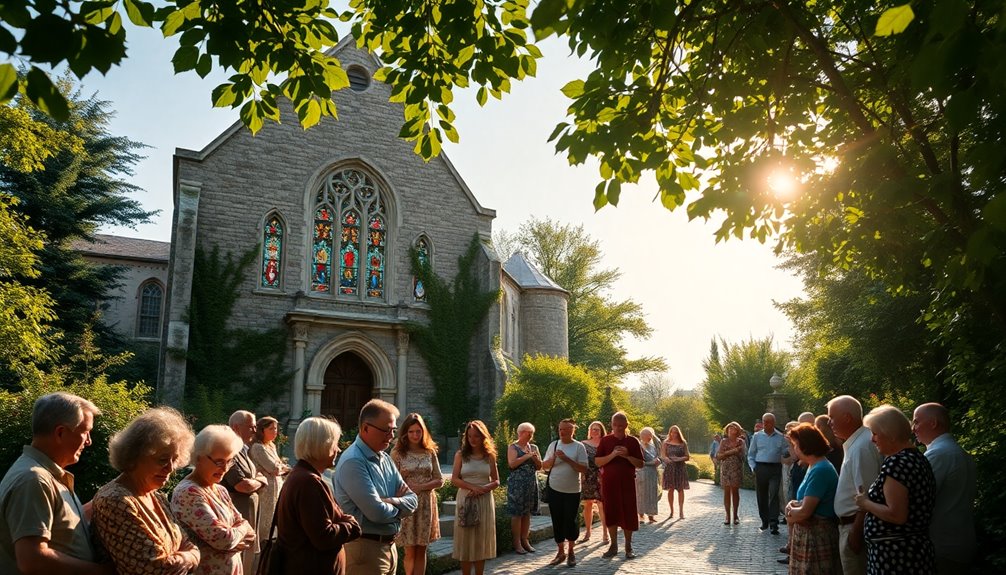
In your daily life, incorporating prayer practices can strengthen your connection with God and provide guidance in challenging moments.
Participating in local outreach initiatives not only helps those in need but also deepens your sense of community and purpose.
Together, these actions can transform your faith into a living witness that impacts both your life and the lives of others.
Daily Prayer Practices
Daily prayer practices are an essential part of life for many Catholics, serving as a way to deepen their relationship with God. These practices often include the recitation of the Rosary, a meditative prayer that focuses on the lives of Jesus and Mary, typically taking about 20-30 minutes.
You might also engage in the Liturgy of the Hours, or Divine Office, which consists of specific prayers and psalms at various times, like Morning Prayer and Evening Prayer, helping to sanctify your daily routine.
Attending Mass is central to Catholic worship, where you participate in prayers of thanksgiving, the Eucharistic Prayer, and receive Holy Communion.
Many Catholics incorporate personal prayer into their daily lives through spontaneous prayers, meditation, or scripture reading. Dedicating time in the morning or evening for reflection allows you to connect with God on a deeper level.
Additionally, making the Sign of the Cross is a common ritual that symbolizes your faith. This simple act invokes the Holy Trinity at the beginning and end of your prayers, helping you remain mindful of God throughout your day.
These daily prayer practices enrich your spiritual life and strengthen your faith.
Local Outreach Initiatives
Prayer practices naturally lead to a greater awareness of the needs within our communities, prompting many Catholics to engage in local outreach initiatives. These initiatives reflect your commitment to community service and social justice, allowing you to make a tangible difference in the lives of those around you.
Parishes often organize food drives and clothing donations to support local shelters, providing essential services to those in need. Through charitable organizations like Catholic Charities, you can help address local poverty, homelessness, and social inequality, ensuring that assistance reaches those who require it most.
Many Catholic schools also incorporate service-learning programs, teaching students the importance of compassion and community engagement. This integration of outreach into education instills values that last a lifetime.
Additionally, events like community health fairs and free clinics are frequently organized by parishes, offering health services and education to underserved populations.
Foundational Impact on Communities
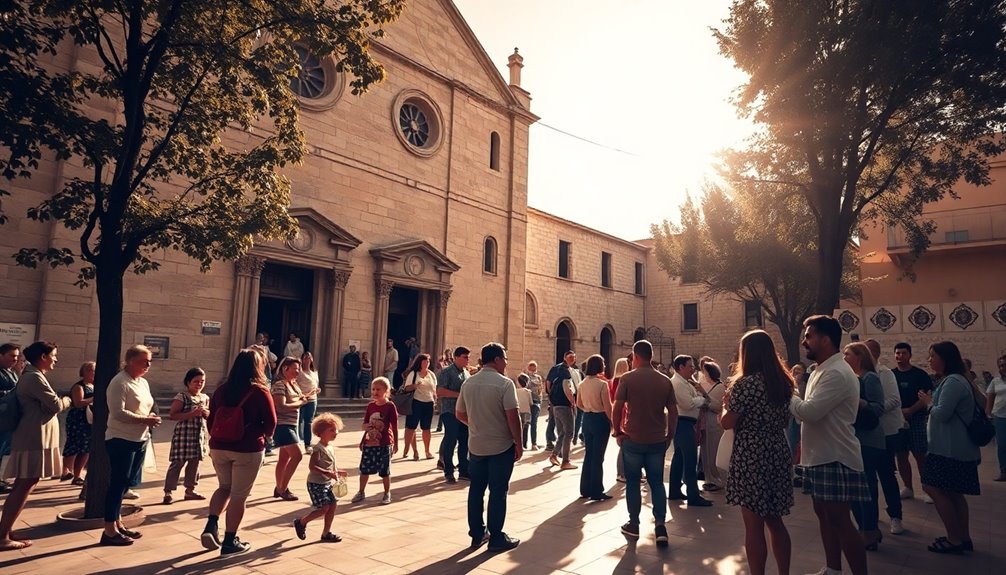
The Catholic Church has profoundly shaped communities throughout history, forging connections that go beyond mere gatherings. Founded by Jesus Christ, it established over 40 Christian communities within the Roman Empire by 100 AD, promoting social cohesion through shared beliefs and practices.
As the Church's hierarchy developed by the end of the 2nd century, local bishops emerged as community leaders, providing spiritual guidance and reinforcing a sense of unity among believers.
Your community benefits significantly from the Church's commitment to education and healthcare. By establishing schools, hospitals, and orphanages worldwide, it became the largest non-government provider of these essential services, enhancing community welfare.
Furthermore, the Church's teachings on social justice inspire congregations to engage in humanitarian efforts, addressing the needs of the poor and marginalized.
The rituals and liturgies, especially the Eucharist, help create communal bonds among members. These sacred practices reinforce a collective identity and shared spiritual purpose, fostering a strong sense of belonging.
Through these foundational impacts, the Catholic Church continues to play a vital role in shaping the fabric of communities, encouraging compassion, service, and connection.
Additional Resources
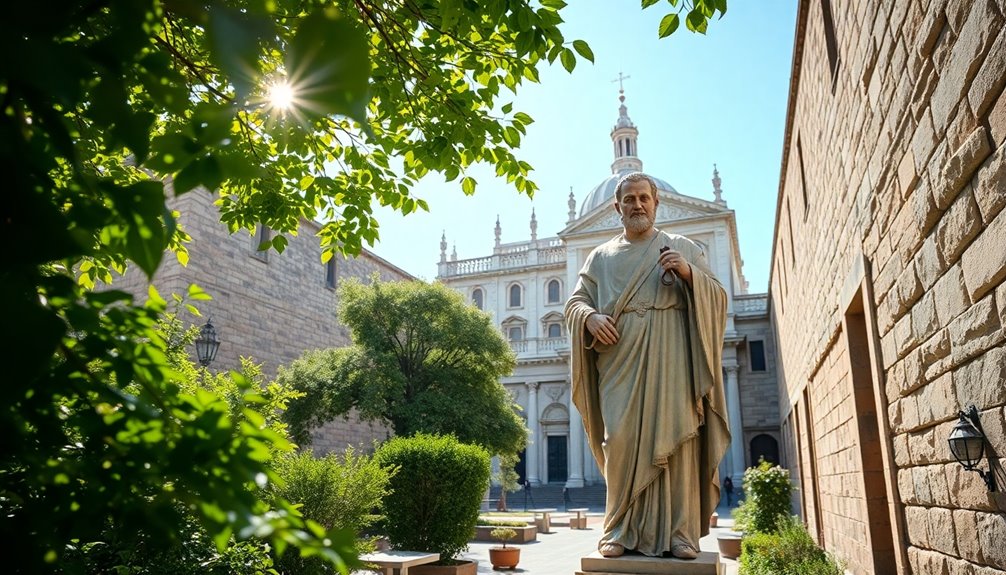
Exploring the rich history and teachings of the Catholic Church can deepen your understanding of its foundational role in society.
To further your knowledge, consider delving into the life and teachings of Jesus Christ, who established the Church and appointed Saint Peter as its first leader, marking the start of apostolic succession.
Look into the significance of Pentecost, when the apostles received the Holy Spirit, empowering them to lead early Christian communities.
You might also explore the distinct identity of the Catholic Church, which was highlighted by Saint Ignatius of Antioch around 110 AD.
Understanding the Council of Jerusalem, convened around 50 AD, will provide insights into how the Church addressed the inclusion of Gentiles without requiring full adherence to Mosaic Law.
Additionally, examining how the Roman Empire facilitated the growth of over 40 Christian communities by 100 AD can offer a broader perspective on the Church's expansion.
These resources will help you appreciate the depth and complexity of the Catholic Church's history and its lasting impact on society today.
Frequently Asked Questions
Who Is the Real Founder of Catholic Church?
When you think about the real founder of the Catholic Church, you might consider the teachings and ministry of Jesus Christ.
He's central to the faith and inspired the community that followed him.
You'll find that St. Peter, recognized as the first pope, played a significant role in establishing leadership.
The Church also sees itself as a continuation of that original community, preserving teachings and traditions throughout history.
When Was the Catholic Church Founded and by Whom?
The Catholic Church was founded around 30 CE, marking the beginning of its public ministry.
You'll find that this period was significant, as it coincided with the coming of the Holy Spirit at Pentecost.
By 100 AD, Christianity had spread across the Roman Empire, thanks to the apostles' efforts.
If you look closely, you'll see the Church's structure evolved over time, establishing a strong foundation for its governance and community.
Where in the Bible Does It Say Jesus Founded the Catholic Church?
You won't find a specific verse that states Jesus founded the Catholic Church directly.
However, in Matthew 16:18, Jesus refers to Peter as the rock upon which he'll build his Church. This indicates the establishment of a community centered on his teachings.
Additionally, the Great Commission in Matthew 28:19-20 emphasizes spreading his message, laying the groundwork for what would become the Church, including its Catholic identity.
Did Peter Start the Catholic Church?
You might wonder if Peter started the Catholic Church.
While he played a crucial role, it's more accurate to say he was a key figure in its early development.
Jesus identified Peter as the "rock" for the Church, and after Jesus' resurrection, Peter led the apostles in spreading the faith.
His authority and leadership laid the groundwork for what would eventually become the structured hierarchy of the Church we recognize today.

